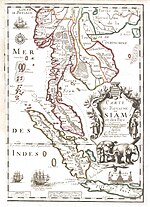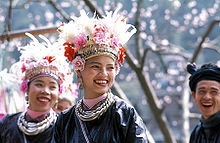Peopling of Thailand
This article needs additional citations for verification. (August 2017) |
| History of Thailand |
|---|
 |

The peopling of Thailand refers to the process by which the
Gradual inland migration of Tai peoples from China
The
was a slow process, with the Tai generally remaining near the mountainous area in the region, where they were able to use their specialized agricultural knowledge relating to the use of mountain water for rice production. The earliest Tai settlements in Thailand were in the river valleys in the northern reaches of the country.Eventually, the Tai settled the central plains of Thailand (which were covered with dense rainforest) and displaced and inter-bred with the pre-existing Austroasiatic population. The languages and culture of the Tai eventually came to dominate the regions of both modern-day Laos and Thailand. In more recent times, many of the Tai tribes of Laos also migrated west across the border, establishing communities in Thailand. The Laotian Tai ethnic groups, often referred to as the Lao, are largely clustered in the Isan region of Thailand.
Origin of the Tai peoples

Comparative linguistic research seems to indicate that the Tai peoples were a
James R. Chamberlain (2016) proposes that the Tai-Kadai (Kra-Dai) language family was formed as early as the 12th century BCE in the middle of the
The Tai peoples, from
Tai ethnic fusion
Over the centuries, the Tai intermarried and absorbed many of the other populations who co-inhabited and/or politically occupied the region, particularly populations of
Individual Tai ethnic groups in Thailand
There are presently more than 30 distinct Tai ethnic groups in Thailand, contributing nearly 85 percent of the nation's population. The genetic stratification of the ethnic clades of the Tai ethnicity is an ongoing topic of debate among linguists and other social scientists.
Continuous diverse Chinese immigration from the 13th century
The history of Chinese immigration to Thailand dates back many centuries, and the specific Chinese ethnic groups which made their way to Thailand are numerous, although there is a greater concentration of Chinese from the southern provinces due to their geographic proximity to Thailand. The Chinese are part of the greater Sino-Tibetan ethnicity which also includes the Tibeto-Burmans. The Chinese immigrants were largely able to merge into the predominant Tai culture, and have contributed significantly to the economy and infrastructure of Thailand over the years.
Chinese immigration during the Ayutthayan Period
Chinese traders in Thailand, mostly from
18th and 19th century male Chinese immigration
In the late-18th century, King Taksin of Thonburi, who was himself half-Chinese, actively encouraged Chinese immigration and trade. Settlers came from Chaozhou prefecture in large numbers.[8] By 1825, the population of Chinese in Thailand had reached 230,000, and it grew steadily due to a constant stream of Chinese immigrants to the country throughout the 19th century. Early Chinese immigration consisted almost entirely of Chinese men, who, of necessity, married Thai women. The children of such intermarriages were called luk-jin (ลูกจีน), meaning 'children of Chinese' in Thai.[9]
20th century immigration of Chinese families
The Chinese population in Thailand had risen to 792,000 by 1910. By 1932, approximately 12.2 percent of the population was ethnic Chinese.[
Lolo migration from Tibet via Burma

Some Loloish tribes such as the Lisu arrived in Thailand as recently as 100 years ago,[11] while others came at a much earlier date. The Lolo are believed to have descended from the ancient Qiang people of western China, who are also said to be the ancestors of the Tibetan, Naxi, and Qiang peoples. They migrated from southeastern Tibet through Sichuan and into Yunnan Province, where their largest populations can be found today.
Origin of the Lolo
The Lolo (also commonly referred to as the Yi) are one of the two major distinct Tibeto-Burmese ethnicities within present-day Thailand, along with the Karen. The Lolo migrated southeast from Burma into Thailand.
Individual Loloish ethnic groups in Thailand
The Loloish of Thailand are generally hill tribes in the northern portion of the country, near the border with Burma. A list of the Loloish ethnic groups of significant size within Thailand are as follows:[12]
- Southern Loloish clade
- Northern Loloish clade
- Lisu (population of approximately 16,000 in Thailand)
Hmong–Mien migration from China via Laos

Like the Lolo, many of the Hmong–Mien ethnic groups are among the hill tribes in Thailand. Their population is clustered in the northeastern region of Thailand near the Laotian border. The Hmong–Mien of Thailand generally migrated from China in the second half of the 19th century through Laos, where they established themselves for some time prior to their arrival in Thailand.[13] An exception to the China-Laos-Thailand migration pattern is the Iu Mien people, who apparently passed through Vietnam during the 13th century, prior to entering Thailand through Laos.[13] The Iu Mien arrived in Thailand approximately 200 years ago, contemporaneously with a large number of other Hmong–Mien migrants.[13]
Origin of the Hmong–Mien peoples
The primary homeland of the Hmong–Mien ethnicity is said to be Kweichow, a province of southern China, where they settled at least 2,000 years ago.[13]
Karen arrival as refugees from Burma
The Karen left
Origin of the Karen
The Karen people's ancestors were from Tibet, and are Tibeto-Burman, and therefore distantly related to the Lolo.
Individual Karen ethnic groups in Thailand
There are approximately 510,000 people of Karen descent living in Thailand.[12] A list of the Karen ethnic groups of significant size within Thailand are:[12]
- Pa'o
- Pwo clade
- Phrae Pwo
- Northern and Western Pwo
- Sgaw–Bghai clade
- S'gaw
- Mae Hong Son Province)
See also
References
- ^ Sagart 2004, pp. 411–440.
- ^ Blench 2004, p. 12.
- ^ Blench 2009, pp. 4–7.
- ^ Blench 2008, pp. 17–32.
- ^ a b c Chamberlain (2016)
- ^ Evans 2002, p. 2.
- ^ Pittayaporn 2014, pp. 47–64.
- ISBN 978-1-4039-6154-9.
- ISBN 978-0-8223-2517-8.
- ^ ARAdmin. "Chinese Migration to Thailand". Retrieved 13 May 2015.
- ^ "BRIEFLY ABOUT THE LISU HILL-TRIBE IN THAILAND". Archived from the original on 2007-03-02. Retrieved 2007-11-01.
- ^ a b c "Thailand". Ethnologue. Retrieved 13 May 2015.
- ^ PMID 17767728.
- ^ Martin Smith (1991). Burma - Insurgency and the Politics of Ethnicity. London and New Jersey: Zed Books. pp. 62–63, 72–73, 78–79, 82–84, 114–118, 86, 119.
